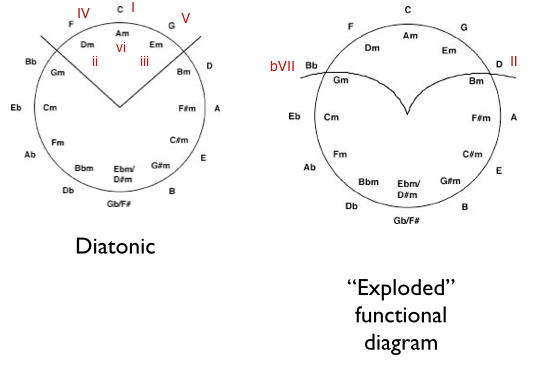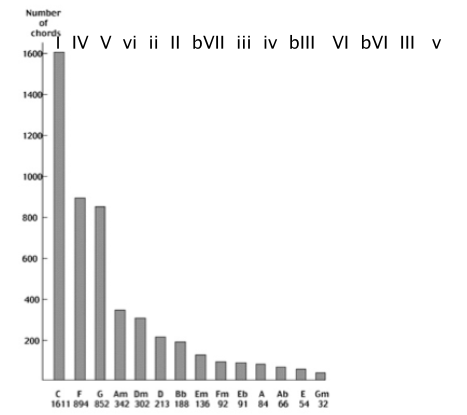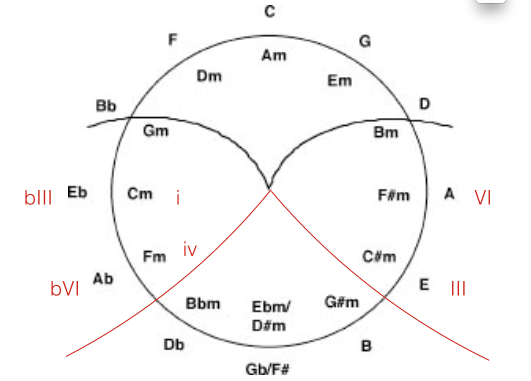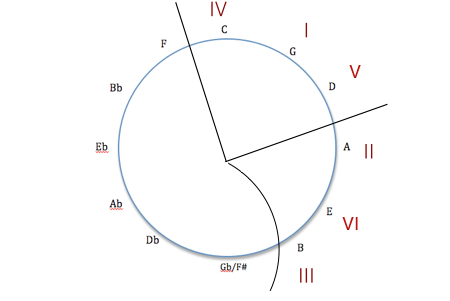
We began the course limiting ourselves to I, IV, and V chords for our country song. Next we filled out the diatonic chord family by adding ii, iii, and vi along with a secondary dominant chord (V of one of the diatonic chords) for our pop song. One of the characteristics of some sub genres of rock is the use non-diatonic chords which J.G. Johansson explores in his article about the "exploded" harmony used by John Lennon and Paul McCartney, the principle songwriters in The Beatles. Read his article and then review the material below.
In this diagram we see the diatonic circle of fifths on the left with lines drawn to corral the diatonic chords used in the key of C major, surrounded by the other major chords F (IV) and G (V) on the outside of the circle, and with the relative minors Dm (ii), Am (vi), and Em (iii) on the inside. On the right those lines have been "exploded" and bent out to include the II and bVII chords that were often used in rock music of The Beatles era. By the 1990s some rock groups are using progressions like C to F#m and C to B for which functional harmony has little to offer as an explanation, and has been effectively "exploded."
In diatonic harmony the ii chord is minor. If you have a D major chord followed by a G major chord in the key of C major we would analyze the D chord as V/V (which we read as "five of five", since D is the V chord in the key of G major.
| D | G | C |
| V/V | V | I |
If, however, you have a D chord in a pop song in C major but it isn't followed by a G major chord we wouldn't call D V/V because it isn't followed by V. Instead we would call it II, since it is a major chord built on the second degree of the scale. We are using capital Roman numerals for major chords and lower case Roman numerals for minor chords.
| D | F | C |
| II | IV | I |
bVII is a major chord built on the lowered seventh degree of the scale. When we build chords on lowered degrees relative to notes in the diatonic scale we precede the Roman numeral with the "b" sign.

After transposing all Beatles songs to C major Johansson counted the frequency of the chords and discovered this distribution. Notice how "exploding" the lines to include Bb and D accounts for the first seven of the most frequent chords, which in order are I, IV, V, vi, ii, II, and bVII.
| C | F | G | Am | Dm | D | Bb |
| I | IV | V | vi | ii | II | bVII |

To account for more of the chords in Johansson's distribution we continue widening the bent lines to include even more chords.
| Em | Fm | Eb | A | Ab | E | Gm |
| iii | iv | bIII | VI | bVI | III | v |

The six remaining chords at the bottom which remain outside of these "exploded" lines (Db, Bbm, Ebm or D#m, Gb or F#, G#m, and B) do not appear in Beatles songs.
Draw a circle of fifths and then add the lines as Johansson makes them bracking I, IV, V, vi, ii, and iii in the key of G major. Add the Roman numeral chord functions. This is what Johansson's looked like for C major.
Transpose yours to G major, so that G is the I chord. [ check your work ]
Now add another set of curved lines to represent exploded lines as has been done above with red lines to include bIII, bVI, VI, and III. When you are done there should only be six chords left outside the curved lines on the opposite side of the circle from G major. [ check your work ]
Ear Training
Listen to the chord progression for the verses in "The Dock of the Bay". Can you figure out what the 4-chord progression is? The song is in G major.
(Sittin' on) The Dock of the Bay - Otis Redding and Steve Cropper
Fill in the chord symbols above the lines of lyrics and the Roman numeral functions underneath.
Sittin' in the morning sun, I'll be
sittin' till the evening comes
Watching the ships roll in, then I
watch them roll away again, yeah I'm just
sittin' on the dock of the bay, watchin' the
tide roll away, ooo I'm just
Sittin' on the dock of the bay, wastin'
time
[ check ]
Here is a circle of fifths analysis of the verses of "Sitting on the Dock of the Bay". Notice that it uses the progression I, III, IV, II.
G B Sittin' in the morning sun, I'll be G: I III C A sittin' till the evening comes IV II G B Watchin' the ships roll in, then I I III C A watch 'em roll away a- gain, yeah I'm just IV II G E sittin' on the dock of the bay, watchin' the I VI G E tide roll a- way, ooo I'm just G A sittin' on the dock of the bay, wastin' G E ti- me.
Review
In this lesson we've seen two ways to analyze non-diatonic chords:
[ Back to Overview ]
[ return to lesson ]
[ return ]

In classical harmony these non-diatonic chords would most likely be accounted for as borrowed chords or mode mixing. A borrowed chord is a one that is borrowed from the parallel key (minor or major with the same tonic). There are different versions of the minor scale, here we are using the Aeolian mode.
| Diatonic chords in C Major | C | Dm | Em | F | G | Am | B° |
| Borrowed from Cm | Cm | D | Eb | Fm | Gm | Ab | Bb |
| Pop theory functions | i | II | bIII | iv | v | bVI | bVII |
Here is an analysis of the chords in the verse of "Dock of the Bay".
[ Back to Overview ]